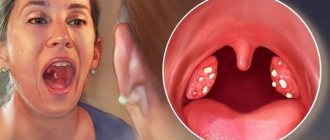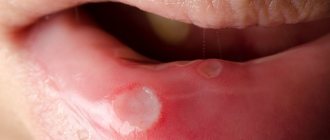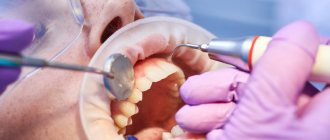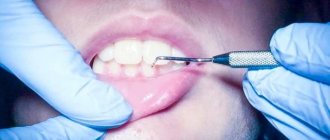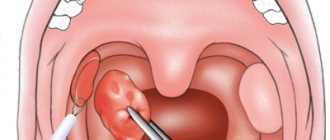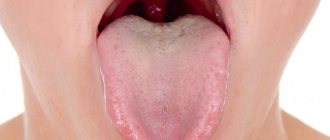Sore throat is one of the most common infectious diseases that affects our tonsils (tonsils). In the medical literature you can find another name for this diagnosis: acute tonsillitis. Purulent sore throat in an adult is an infectious disease that is provoked by pathogenic microorganisms, namely hemolytic streptococci of groups A and B, and less commonly staphylococci.
The disease is extremely contagious. The disease is transmitted not only by airborne droplets. You can become infected through contact when sharing the same dishes or towels with a sick person. Both children and adults are susceptible to the disease.
This disease has a clearly defined seasonality and most often appears in the autumn-spring period.
Despite the fact that many people treat the diagnosis of “acute tonsillitis” as something natural and commonplace, nevertheless, this disease is not as simple as it seems. If there is a careless attitude towards it, when proper treatment of purulent sore throat in adults is not carried out, severe complications can develop, involving associated organs (kidneys, joints and myocardium - heart muscle) in the chronic inflammatory process.
Symptoms of purulent sore throat
The disease begins acutely. Almost simultaneously, general and local symptoms appear, which reach their maximum development on the second day1,4.
General symptoms:
- fever up to 39-400 C1;
- chills;
- headache;
- weakness;
- feeling overwhelmed;
- aches and pain in muscles and joints;
- Children may have nausea, vomiting and abdominal pain1,4.
Local symptoms:
- sore throat that gets worse when swallowing and sometimes radiates to the temple or ear;
- dryness, soreness and soreness in the throat;
- increased secretion of saliva;
- spasm of the masticatory muscles on the side of inflammation is possible, which prevents you from opening your mouth wide;
- enlargement and tenderness of the cervical lymph nodes1.
Up to contents
What does a purulent sore throat look like?
The picture that can be seen when examining the throat depends on the form of the disease.
Follicular tonsillitis
The functional tissue of the tonsils consists of follicles - individual “islands” of lymphoid tissue. Follicular tonsillitis is a purulent inflammation of the follicles1.
Initially, the tonsils swell, increase in size, and become red. Then yellow-white dots begin to appear on the red background - pus, which accumulates in the follicles1,3.
Lacunar tonsillitis
Lacunar tonsillitis begins in the same way as follicular tonsillitis, with enlargement and redness of the tonsils. Then pus appears in their numerous depressions (lacunae). It appears on the surface in the form of yellowish-white islands, which gradually increase in size and merge with each other1,3.
Up to contents
Treatment of tonsillitis in Moscow
Chronic tonsillitis in Moscow, in fact, like the acute form of the disease, should be treated only by an otolaryngologist. The main thing is to choose the right medical institution where you will receive qualified assistance. Treating tonsillitis at the Doctor Zaitsev clinic means entrusting your health to professionals. Modern equipment and patented treatment methods allow us to provide the most effective care to patients. Our prices remain one of the best in Moscow, since our price list remained at the 2013 level. You can sign up for the clinic by calling the reception desk daily from 9 a.m. to 9 p.m. or through the online registration form on the website. Come, we will be glad to help you!
Causes of purulent sore throat
The immediate cause of inflammation of the tonsils is the penetration of infectious agents into them - viruses, bacteria, fungi. However, the disease develops mainly against the background of a decrease in the body’s defenses1.
The impetus for the development of tonsillitis can be:
- hypothermia: the disease occurs especially often in the autumn-winter and spring periods1;
- unbalanced diet, leading to hypovitaminosis and weakened immunity3;
- tonsil injuries, for example, from rough food3;
- nervous system disorders3;
- inflammatory diseases of the nose, paranasal sinuses, oral cavity3.
The palatine tonsils are located at the intersection of the respiratory and digestive tracts. Therefore, they can be affected by microbes from the mouth, nose and throat1.
Most often, purulent inflammation of the tonsils is associated with streptococcal infection2. The most severe forms of the disease are caused by beta-hemolytic streptococcus of group A2,3,4. It is found in 15% of adults with purulent tonsillitis and in 20-30% of children2.
Streptococcal infection is contagious. Patients and even those who have recovered from tonsillitis can be a source of infection for healthy people for 10-12 days1.
Streptococcus often leads to rheumatic diseases and damage to internal organs. Therefore, if signs of purulent tonsillitis appear, you should definitely consult a doctor to find out which microorganism caused the inflammation. Today, rapid tests are used to diagnose streptococcal infections, which show results with an accuracy of 99% within 15-20 minutes5.
Viral tonsillitis is usually caused by pathogens of acute respiratory infections:
- adenoviruses;
- influenza and parainfluenza viruses;
- rhinoviruses1,3;
- herpes simplex virus;
- Epstein–Barr virus;
- cytomegalovirus4 and others.
Sore throat is one of the manifestations of measles, scarlet fever, infectious mononucleosis and blood diseases1. Only a specialist can understand the intricacies of the disease.
Up to contents
Why does infection occur?
In the vast majority of cases (60-80%), the causative agent of the disease is streptococcus bacteria. Less commonly - staphylococci and pneumococci. There are always microorganisms throughout the human body and in the palatine tonsils in particular. When a person’s health is normal and his immunity is not weakened, they do not manifest themselves in any way. But as soon as the body’s defenses fail in the presence of factors predisposing to the disease, pathogens become more active. If a person shows the first signs of a sore throat, it means that pathogenic microorganisms have penetrated deep into the tonsils and triggered the inflammation mechanism.
The reasons that provoke the inflammatory process include:
- prolonged exposure to the cold, cold drinks or food (sometimes it is enough to eat ice cream or fall asleep with the air conditioner on);
- tonsil injuries;
- reduced immunity;
- lack of full breathing through the nose due to the anatomical features of a person (adenoids, polyps, cysts in the nose and nasopharynx);
- inflammation present in the body;
- bad habits, especially smoking;
- unfavorable environmental conditions;
- unfavorable working conditions.
How long does a sore throat last?
The duration of the disease depends on its form and severity. The total duration usually does not exceed 7 days4.
Regardless of how long a purulent sore throat is treated, the doctor states recovery only 5 days after the temperature normalizes. In this case, the patient’s sore throat should disappear, and the lymph nodes should become painless. In addition, the results of blood tests, urine tests and electrocardiograms are always taken into account3.
Up to contents
Washing the tonsils.
The procedure for washing the tonsils has a great positive effect, as a result of which pus is released from the lacunae and the medicine is administered. There are several ways to carry out the procedure.
The oldest, so to speak, ancient method is sanitation with a syringe. It is used quite rarely due to its low efficiency and traumatic nature, compared to the advent of more modern methods. The syringe is used when the patient has a strong gag reflex or very loose tonsils.
In other cases, a more effective method is used - vacuum rinsing with a special attachment of the Tonzillor apparatus.
But it is not without its drawbacks:
- the container into which the purulent contents of the tonsils are “pumped out” is opaque, and the doctor cannot see whether the rinsing is complete;
- The design feature of the nozzle is such that when the pressure necessary for complete rinsing is reached, the nozzle can injure the tonsils.
Our clinic for the treatment of tonsillitis offers its patients an alternative painless option for washing the tonsils using the improved “Tonsillor” nozzle - this is the “know-how” of our clinic. There are no analogues of our nozzle in other medical institutions in Moscow. It eliminates the disadvantages of a conventional nozzle: the rinsing container, which is suctioned to the tonsil, has transparent walls, and the otorhinolaryngologist can see what “comes out” of the tonsils. This eliminates unnecessary manipulations. The nozzle itself is non-traumatic and can be used even by children of school age.
Treatment of purulent sore throat in adults and children
A doctor should treat tonsillitis. He will determine the form of the disease and prescribe the necessary medications. Self-medication can lead to a protracted course of the disease and complications.
In order not to infect others, a patient with acute tonsillitis must be isolated and given separate dishes and a towel1.
During the period of fever, strict bed rest is indicated, and after the temperature drops, semi-bed rest and home rest1,3.
Plenty of warm drinks and gentle nutrition are recommended, which does not irritate a sore throat. Typically, doctors recommend a dairy-plant diet with a limited amount of carbohydrates and a high content of vitamins1,3.
Drug treatment includes general and local drugs.
To fight infections and inflammation and relieve the symptoms of tonsillitis, your doctor may prescribe the following medications:
- antibiotics;
- anti-inflammatory;
- antiallergic;
- antipyretics1,3.
Local treatment of follicular and lacunar tonsillitis includes gargling or irrigating the throat, as well as the use of absorbable tablets with antiseptic, anti-inflammatory and analgesic effects. The goal is to mechanically cleanse the tonsils of pus, fight the pathogen, sore throat and inflammation2.
Up to contents
How to treat peritonsillar abscess?
Treatment is carried out in two stages:
- Surgical.
- Conservative.
First of all, it is necessary to evacuate the pus from the peritonsillar space.
This can be done in the following ways:
A) Tonsillectomy - removal of the tonsils.
B) Puncture (puncture) and aspiration.
B) Opening (incision) and dividing the paratonsillar space.
After draining the pus, the patient should receive antibacterial and anti-inflammatory therapy.
Consequences of purulent sore throat
Acute tonsillitis can occur with complications. They are usually divided into local and general.
Local complications:
- paratonsillar abscess - an abscess that forms outside the tonsil when infection penetrates into the surrounding tissue;
- acute otitis media – inflammation of the middle ear;
- acute laryngitis - inflammation of the larynx;
- cervical lymphadenitis – inflammation of the lymph nodes1.
General complications occur more often with streptococcal sore throat4, these include:
- rheumatism;
- rheumatoid arthritis;
- myocarditis;
- polyarthritis;
- glomerulonephritis and pyelonephritis;
- pneumonia and others1.
Up to contents
Step-by-step procedure for removing pus from tonsils
The procedure for getting rid of purulent plaque is simple; its difficulty lies in carrying out the manipulation yourself in compliance with all sanitary standards.
How to deal with ulcers at home:
- Use a hard object to press on the area near the plug; a white liquid will appear on its surface.
- The object must be surgical tweezers, a pencil, a teaspoon handle.
- The manipulation is carried out near a mirror in a illuminated place. A person's hands must be completely free.
- It is necessary to disinfect the item by wiping it with alcohol.
- Tweezers or a spatula should be wrapped in a piece of sterile bandage, after moistening it in Furacilin or another antibacterial agent.
- The object is brought to the throat carefully, because the abscess is removed with the slightest pressure.
After the manipulation, it is necessary to clean the tonsils from any remaining pus, so the throat is gargled with chamomile decoction, saline solution, and Furacilin. If you use hydrogen peroxide, then after the procedure you will also have to wash off this medication.
Hexoral against purulent sore throat
For acute tonsillitis, all drugs from the HEXORAL® line can be used.
You can treat the throat with a sore throat (acute tonsillitis) using HEXORAL® spray based on hexethidine. It allows you to evenly cover the surface of the mucous membrane of the tonsils and pharynx, which contributes to a more effective fight against infection8. A solution of HEXORAL® with hexethidine and a combination of essential oils7 may be suitable for gargling.
The use of hexetidine preparations is prescribed in clinical guidelines for the treatment of acute tonsillopharyngitis2. Hexetidine is an antiseptic that is active against most bacteria, herpes simplex viruses type 1, influenza A, PC virus that affects the respiratory tract, and fungi. In addition, it has a mild analgesic effect7.
Both HEXORAL® spray and solution are approved for use for local treatment of tonsillitis in adults and children over three years of age7,8.
Lozenges with a neutral mint flavor HEXORAL® TABS based on chlorhexidine and benzocaine have antiseptic properties and analgesic properties. They are approved for use in adults and children aged 4 years and older9.
For adults and children over 6 years old, HEXORAL® TABS CLASSIC is available with the flavors of orange, black currant, lemon and honey. It is based on a combination of the antiseptics amylmetacresol and dichlorobenzyl alcohol, which help in the fight against tonsillitis pathogens10.
HEXORAL® TABS EXTRA may be suitable for children over 12 years of age and adults. In addition to the antiseptic component, it contains lidocaine, which can relieve even severe sore throat11.
The information in this article is for reference only and does not replace professional advice from a doctor. To make a diagnosis and prescribe treatment, consult a qualified specialist.
Up to contents
Literature
- Dergachev V. S. Angina. Clinic, diagnosis and treatment algorithm. Choice of local antibacterial therapy // Regular issues of “RMZh” / No. 18. – 2007. – P. 1350.
- Clinical recommendations Acute tonsillopharyngitis // National Medical Association of Otorhinolaryngologists / 2016.
- Kunelskaya N.L., Turovsky A.B., Kudryavtseva Yu.S. Sore throats: diagnosis and treatment // General Medicine / No. 3. – 2010. – P. 4-9.
- Krasnova E.I., Khokhlova N.I. Differential diagnosis and treatment tactics for acute tonsillitis (tonsillitis) at the present stage // Attending physician / No. 11. – 2021. – P. 58-63.
- Shcherbakova M. Yu., Belov B. S. A-streptococcal tonsillitis: modern aspects // Pediatrics / Volume 88. - No. 5. – 2009. – P. 127-135.
- Instructions for use of the drug HEXORAL® solution // Reg. number P N014010/02 //
- Instructions for use of the drug HEXORAL® aerosol // Reg. number P N014010/01 //
- Instructions for use of the drug HEXORAL® TABS // Reg. number LSR-002626/07 //
- Instructions for use of the drug HEXORAL® TABS CLASSIC // Reg. number P N015976/01 //
- Instructions for use of the drug HEXORAL® TABS EXTRA // Reg. number LSR-004122/09 //
Up to contents
Diagnostics
Timely and, most importantly, correct diagnosis is an important step on the path to recovery. The diagnosis, as well as the treatment of the throat with an abscess, is carried out by an otorhinolaryngologist. The clinical picture of the disease, as a rule, is so indicative that making a correct diagnosis is not particularly difficult.
At the initial consultation, the ENT doctor collects the patient’s medical history and complaints: the presence of recent sore throat or exacerbation of chronic tonsillitis, dental problems or mechanical damage to the walls of the pharynx is clarified. The ENT doctor finds out how the inflammation of the tonsils was treated (in the case of tonsillitis), and when the patient’s well-being worsened.
Then a direct examination of the patient is performed: in some patients, an involuntary tilt of the head towards the inflamed area of the pharynx is immediately noticeable, an unpleasant odor is felt from the oral cavity, and enlarged lymph nodes are clearly palpable.
The most obvious method of research for this condition is pharyngoscopy, which allows you to determine the area of localization of the abscess.
If we are dealing with a lateral form of phlegmon location or if complications are suspected, the patient is prescribed an ultrasound and CT scan of the neck.
If the problem is not diagnosed in time and the throat is not treated, dangerous complications may develop:
- phlegmon of the neck (purulent inflammation of the tissues of the neck);
- mediastinitis - inflammation of the mediastinum;
- blood poisoning;
- laryngeal stenosis, which can lead to suffocation.
Such complications of a left-sided abscess, as well as a right-sided one, can be fatal.
Medicinal preparations for rinsing
It is easy to get rid of purulent plugs with plain water, but it is recommended to use medications to rinse the throat. This remedy will remove plaque, destroy the causative agent of the disease and improve the condition of the mucous membrane during a sore throat.
There are several common preparations for rinsing with purulent sore throat.
- Potassium permanganate. To prepare the liquid, you will need to dissolve a couple of potassium permanganate crystals in 200 ml of warm water. The dosage is calculated for one rinse. It is recommended to filter the solution so that the grains do not scratch the already affected throat. Rinsing is carried out 4 times a day.
- Saline solution. For a sore throat, this is the most popular remedy; to prepare it, you need to dilute 1 tsp in 200 ml of warm water. soda and salt. For a quick effect, add a couple of drops of iodine to the liquid. The procedure is carried out 4 times a day, combined with other medications.
- Boric acid. To prepare the solution, pour 2.5 grams of 1% dry product into a glass of warm water. The liquid is used for rinsing with ulcers 3 to 5 times a day.
- Chlorophyllipt. The natural-based drug has an anti-inflammatory, immunostimulating and restorative effect. Add 1 tsp to a glass of warm water. medical product. It is necessary to gargle three times a day; it perfectly removes surface deposits.
- Furacilin. The drug tablet is crushed and dissolved in a glass of warm water. The product is used 2 to 4 times a day.
- Chlorhexidine. The drug has an antiseptic effect. Before using it, it is recommended to gargle with warm boiled water and brush your teeth. For the procedure, take a 0.05% solution, which you need to gargle for 30 seconds and spit it out.
It is prohibited to use different medications for purulent sore throat without first consulting a doctor. Some products can be harmful to the body. Inhalipt, due to its increased viscosity, slows down the discharge of pus.

